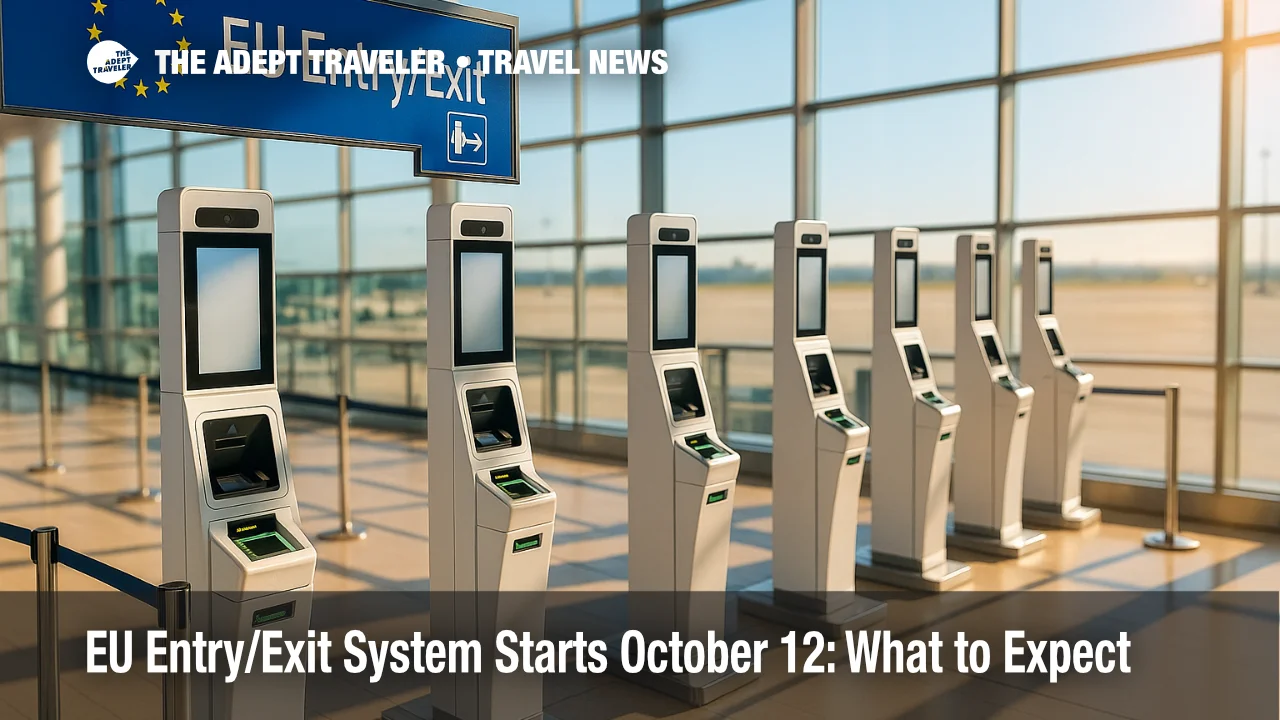EU entry/exit system starts October 12: what to expect

Travelers heading to Europe in October will start encountering the European Union's new entry/exit system, which replaces passport stamping with biometric checks at external borders. The rollout begins October 12, 2025, and will expand progressively over several months, with full operational coverage expected in April 2026. The system registers passport details plus fingerprints and a live facial image for most non-EU visitors, then logs each entry and exit to help enforce short-stay rules.
Key points
- Why it matters: First-time enrollment adds steps at border control and may lengthen arrivals during the ramp-up.
- Travel impact: After initial registration, repeat crossings should be quicker with passport scans and a photo check.
- What's next: Phased adoption through early 2026 at "select" air, land, and sea border points.
- Children under 12 are exempt from fingerprinting; face images and document data are still recorded.
- Applies to Schengen countries, including Iceland, Liechtenstein, Norway, and Switzerland; not Ireland or Cyprus.
Snapshot
The EU's entry/exit system (EES) begins on October 12, 2025, at selected external border points, then scales up across 29 participating European countries in stages. First-time travelers subject to EES provide four fingerprints and a live facial image alongside passport data; subsequent trips typically require only document and photo verification within a three-year window. Authorities will keep records of entries, exits, and refusals for three years, with longer retention if no exit is recorded. Early deployments will vary by country and border type, so experiences may differ, especially at busy crossing points. U.S. travelers should expect automated checks on arrival and departure and allow extra time while airports, ports, and land terminals refine passenger flows.
Background
EES is a long-planned replacement for manual passport stamping, designed to automate border checks, curb fraud, and more reliably track the "90 days in any 180 days" rule for visa-exempt visitors. The European Commission confirms the start date of October 12, 2025, followed by a progressive start at select border posts, with full coverage targeted for April 10, 2026. The system applies to non-EU nationals entering Schengen for short stays; Ireland and Cyprus are not part of EES, while the non-EU Schengen states of Iceland, Liechtenstein, Norway, and Switzerland are included. The European border-IT agency eu-LISA manages the platform. EES is separate from ETIAS, the advance travel authorization with a fee, now expected after the EES rollout is complete in late 2026.
Latest developments
Phased October launch and staggered checkpoints
From October 12, 2025, participating countries will activate EES at selected external borders, then add more locations in phases through early 2026. Authorities have signaled a staggered approach to reduce queues, beginning at certain air, sea, and land crossings. Switzerland plans to activate EES at Geneva, Zurich, and Basel airports from October 12, while France and others will ramp up progressively. Operators on high-traffic UK-EU routes have also invested in kiosks and staffing to manage first-time enrollments, with some locations initially prioritizing coaches and freight before expanding to private cars and all rail passengers. Expect procedures to differ by border, especially during the first months of operation.
Analysis
EES changes the first-arrival experience for millions of U.S. and other visa-exempt travelers, front-loading a one-time biometric capture to speed subsequent trips within three years. The phased strategy, plus the ability for authorities to adjust flows if processing times spike, is intended to prevent the long lines seen in earlier trials and system transitions. Still, the greatest risk window is autumn into the holiday period, when staffing and passenger learning curves collide. Rollout asymmetry matters: airports or ports that install more kiosks and floor staff early will move faster than those that scale incrementally. For travelers, practical prep helps. Know your document validity, remove hats and sunglasses before the kiosk, and keep fingers clean and dry for the scanner. Families should note the under-12 fingerprint exemption, but older children will enroll like adults. Finally, keep EES distinct from ETIAS. The authorization fee and pre-trip application are not live yet; news of ETIAS demand or denials should not affect your fall and winter 2025 travel unless and until the authorization system launches.
Final thoughts
Allow extra time at arrival in October and November, especially if you are a first-time entrant under the EU entry/exit system. Once enrolled, later trips should be faster, and the digital record ends the uncertainty of manual passport stamps. Keep an eye on your specific airport, port, or rail terminal for local procedures, and remember that ETIAS is a separate step projected for late 2026, after the EU entry/exit system is fully in place.
Sources
- Entry/Exit System (EES) - European Commission
- What is the EES? - Travel to Europe (official EES site
- FAQs - Travel to Europe (fingerprints under 12; progressive start
- Travel in Europe with the EES - European External Action Service
- Information campaign launched on the EES - eu-LISA
- Americans traveling to most of Europe will have fingerprints scanned - CBS News
- Schengen launch details, Switzerland airports - CERN notice
- Data retention and records - French Interior Ministry (EES privacy)
